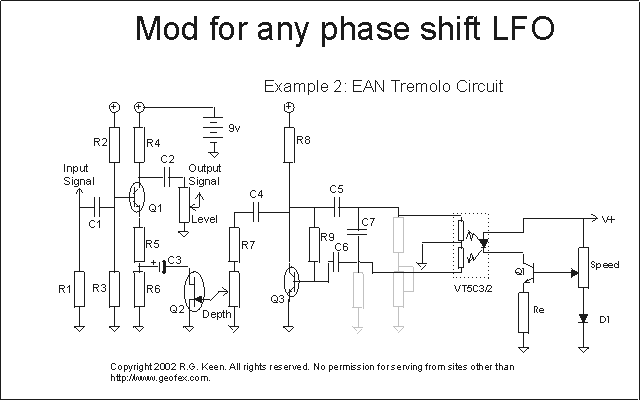
Here's a trick to get rid of those pesky dual section, odd taper pots for speed controls and a way to get wider range out of your swept pedals that use the phase shift oscillator style sweep.
Where it really shines is in the univibe. The 'vibe uses a dual section, reverse log taper pot that's just a bit easier to find than a dinosaur's tooth. If we notice that the pot is really wired as two variable resistors, we can use an LED/dual LDR module like the VT5C3/2, which costs about $5 from Newark and other electronics distributors. To give us good control, we use a transistor to vary the LDR current. With a single 10K pot for speed, the transistor varies the current in the LED from nearly off to a voltage set by the V+ voltage minus the LED 1 voltage and the Vbe of the transistor. You take that voltage, divide by the max current you want in your LED, and insert that resistance into Re. The 'vibe circuit has resistors to limit the min and max resistance the circuit sees. I did this in my tube univibe, and it works great. You can mess with the taper of the single speed resistor (See The Secret Life of Pots) to adjust the effective taper of the speed control pot as you like it.

Here's how to add the same thing onto a tremolo. The Trem Face is a nonstandard kind of trem, but it uses a voltage-driven version of the phase shift oscillator for an LFO. Again, cut out the dual pot, and replace it with the transistor/pot/VT5C3/2. In this design, you may want to remove LED1 to give yourself a little more voltage variation on the speed pot.

Here's how to hook it into the EAN tremolo. "But wait!" I hear you saying, "The EAN tremolo doesn't use a dual pot!"
That's correct. The designer settled for the limited oscillation range they could get by varying only one of the two resistors available for controlling speed in the phase shift oscillator. By varying both, you get a much wider range of control from slowest to fastest.

Notice that once you have this set up, the speed is voltage controlled. You can feed a voltage into the base of the transistor and the speed of the oscillator will follow it. Useful things to do this with are (1) expression pedals (2) a synchronizing signal for operating multiple pedals in synchrony (3) an envelope detector (4) a random voltage generator similar to one of the ones in the Pseudorandom LFO article here on GEO.
Have fun!